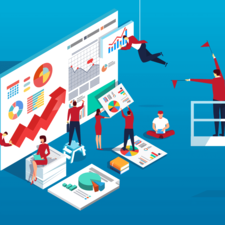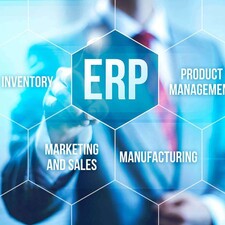Blog
Business Intelligence (BI) in ERP Systems Has Never Been More Valuable

Summary
Use Your Data to Drive Quick, Top-to-Bottom Decision Making
Business Intelligence (BI) is data transformed into actionable insights that support better, faster decision making. Business intelligence ERP systems can be your organization’s eyes and ears, allowing you to monitor your chosen key performance indicators and make changes when those KPIs aren’t where they should be.
We explored the value of BI in a popular 2015 blog, The Value of Business Intelligence in ERP Systems, and we wanted to update that post by detailing many of the emerging improvements in BI since then, describing how they can help your business work smarter. In order to do this, we spoke with Tony Moraco, abas USA’s Upgrade/BI Manager.
How BI Gets Delivered Has Changed
Data and BI has always been valuable to companies, and it’s long been at the core of good business decision making, but what’s changed over the last few years is the sheer volume of data that’s able to be stored and compiled. With all that available data, there needs to be a means to organize it all in ways that make sense for businesses, which is where business intelligence in ERP comes in.
“As technology has evolved, BI has evolved along with it,” said Moraco. BI doesn’t just provide standardized dashboards and reports, but can compile and display the exact data that companies deem most relevant, in multiple areas. BI is also increasingly distributed across the organization, allowing for the democratization of data and BI from the C-suite/leadership to the ground or shop floor.
With BI, you have the ability to predict trends based on historical data and trends
Combining cloud technologies with BI gives abas ERP the ability to create dashboards that senior management, end users and everyone in between can access. Beyond just viewing, the capability enables users to manipulate and create a user-centric dashboard that’s relevant for them from data sources in and outside of abas. Anyone with authorization can access relevant data and use it.
Let’s look at an example. An employee operating a machine can view a monitor that displays the equipment’s performance, its efficiency. The end user can quickly visualize relevant data, as opposed to waiting for the end of the day for all that data to get collected and then creating some report saying, “machine A was a lot slower on Tuesday than machine B.” Instead, the user can see that in real time.
So when something is wrong, the operator of the equipment can identify the issue fast and either make changes or seek assistance -- there’s less need to wait for the higher-ups to diagnose problems and proscribe solutions, which is time consuming and costly.

Business Intelligence ERP Systems Enable a Proactive Stance, Keeping Your Business on the Front Foot
The next step after diagnosing issues, one that’s emerging with BI now, is the ability to use data to see historical patterns and make smart, data-informed predictions about the future. “Predictive analytics is now coming to the forefront,” says Moraco. “Based off of historic trends, you have the ability to predict trends.”
With BI, you can make better, data-informed decisions about sales, production, inventory, and distribution
Sales forecasting is a common example, such as which colors sell during certain times of the year, but can even be applied to areas in production. For example, if machine performance data is being captured, it is possible to determine failure rates of machines to anticipate machine maintenance requirements and schedule, rather than waiting to be reactive to a failing machine. Once the pattern is identified, BI software lets you drill down into the details to find root causes. All of this supports better decisions about next steps. “You can make better, data-informed decisions about sales, production, inventory, and distribution,” Moraco says.
The Value of Cubes to Monitor Your Chosen KPIs
Having so much data at your fingertips isn’t about making pretty reports: it’s seeing trends that can help a business make better decisions, whether that’s for revenue growth, cost cutting, equipment maintenance, or being more proactive instead of reactive in key business areas.
Even better, BI software allows users to “slice and dice” their data, configuring and displaying it in ways that make the most sense for their particular performance needs. BI software uses cubes to make customized, on-the-fly reporting easy enough for nontechnical users to do. These cubes can store your raw data and enable users to quickly see just the piece they need. “The true value is in having these pre-defined cubes so that the end user can decide on how they want their data to be presented,” explains Moraco.
BI and abas ERP are relevant for many different industries and different types of users. It’s hard to come up with standard reports that are relevant for every single entity. So each industry and each company has their own metrics. To get the full value of BI software, businesses need to decide what drives their business, what questions are relevant to be answered in BI. In the end, it’s up to the user to define how they apply that data to drive their decision-making.
The Takeaway
Ever-improving BI software in ERP systems is a great tool for monitoring business performance in real time, from the top of the organization to the ground floor, and BI capabilities will only continue to develop in ways that support better, data-driven decision-making.

Just starting your ERP selection process? Make sure your new ERP takes advantage of the power of BI. Download your copy of the Writing a Better ERP RFP guide or start a conversation with one of our ERP experts by contacting us.


